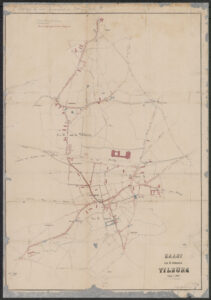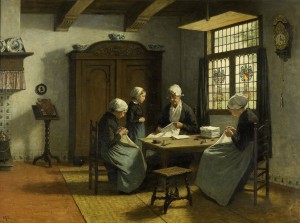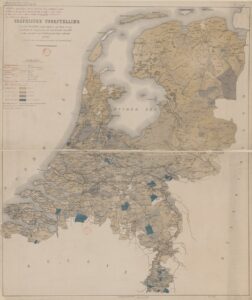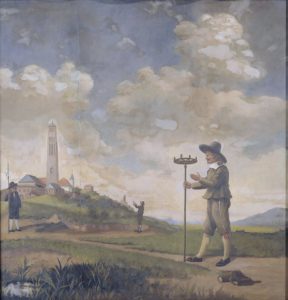This week we are looking at an often overlooked part of our ancestors' lives: a sewage map. This map shows the network of sewage pipes in Tilburg in 1870. In the 1800s, many municipalities undertook works to improve public health. The cholera outbreak of the 1860s and the discovery of the role of water contamination by raw sewage led to installation of sewage systems all over the country. The Tilburg map shows that by 1870, sewage pipes ran through large parts of the center, though … [Read more...]
Dutch Genealogy News for August 2024
This is an overview of the new sources, projects, and other news announced this past month. Sources 57 newspapers (almost 155,000 issues) have been added to Delpher, where they can be searched full-text. This includes several local and regional papers, including for Utrecht, Groningen, Zwolle, and Breda. You can search in the latest additions. The Streekarchief Midden-Holland, the archives for the region around Gouda, have digitized several cemetery registers. Municipalities were … [Read more...]
German Genealogy Headquarters
Great news for people who have German ancestors! My friends Ursula Krause and Ute Brandenburg just founded German Genealogy Headquarters. They can help you with research, mentoring, or education. They are organizing virtual German genealogy symposia. The first one is on Saturday 7 September 2024 with a focus on German History and the Role of the Church in Everyday Life. Registration is now open at a discounted rate. Check their Education page for their plans for the rest of 2024 and 2025. … [Read more...]
Source – Staatscourant [National Gazette]
The Staatscourant [National Gazette] is the official newspaper of the Dutch government. Established in 1814, the gazette publishes all laws, regulations, and other official announcements of the Netherlands. Genealogical information in the Staatscourant Some announcements deal with individuals. A few examples of genealogical information you can find in the gazette: Appointments, transfers, promotions, or pensions of civil servants, including public school teachers, police officers, etc. … [Read more...]
Map of the Week – Goeree-Overflakkee over time
This week we are looking at a map of the island of Goeree-Overflakkee, including two historical maps. The center of the map shows the island as it was in 1842, when the map was created. The island was then called Goedereede en [and] Overflakkee. On the left shows the situation in 1750, when the islands of Goeree and Overflakkee were still seperated at high tide. The right shows the situation around 1300, when the claiming of land had just started. Today, the combined island is part of the … [Read more...]
Quick tip – Look for Employees and Officials
Records often mention two groups of people: the people who the records are about, and the people who work for the organization that created the records. As genealogists, we often only think about the first category. But we can learn a lot from the records about the employees or officials too. A few examples: Record About Employees or officials Civil registration people who are born, married, or died mayor, aldermen, clerks witnessing records Police … [Read more...]
Map of the Week – Veendam, circa 1868
Between 1865-1868, Jacob Kuyper published a series of atlases with municipal maps. These show the location of all the hamlets, villages, and larger towns in the municipality, as well as the main roads and railroads. The Kuyper maps are often available at the websites of archives or via Wikimedia Commons. This week we are looking at Veendam, a municipality in Groningen. "Veendam" means "peat dam." The thin rectilinear plots reflects its peat mining history. The area was known for shipbuilding. … [Read more...]
Dutch term – Gaarder
A gaarder is a collector, typically of taxes or tariffs. You may come across the term doing research in the province of Holland between 1695 and 1806, when a special tax ("impost") was levied on marriages and burials. The duties that had to be paid depended on the economic circumstances of the bridal couple or the deceased. The records of those taxes are known as the gaarderboeken [collectors' books]. These records can be used as substitutes for marriage and burial records. The actual … [Read more...]
Map of the Week – Children not in School, 1887
This week we are looking at a thematic map from 1887. It shows the percentage of children between the ages of 6 and 12 who were not in primary school. The statistics were shown per municipality. The darkest blue color represents areas where more than 30% of children did not go to school. A zoomable version is available at Gallica. The map shows great differences between parts of the Netherlands. In general, municipalities in the north had higher school attendance than municipalities in … [Read more...]
How to Convert Old Dutch Weights and Measures
In the Netherlands, the metric system was introduced in 1816. Before that time, different areas used different weights and measures. Not only did they use different terms, but the amount indicated by the term could differ from one place to the next. The Meertens Instituut website has an overview of all the different measures in the country, organized by town, province, or type of measure/weight. If you come across a weight or measure in a record, you can use this website to figure out how … [Read more...]











